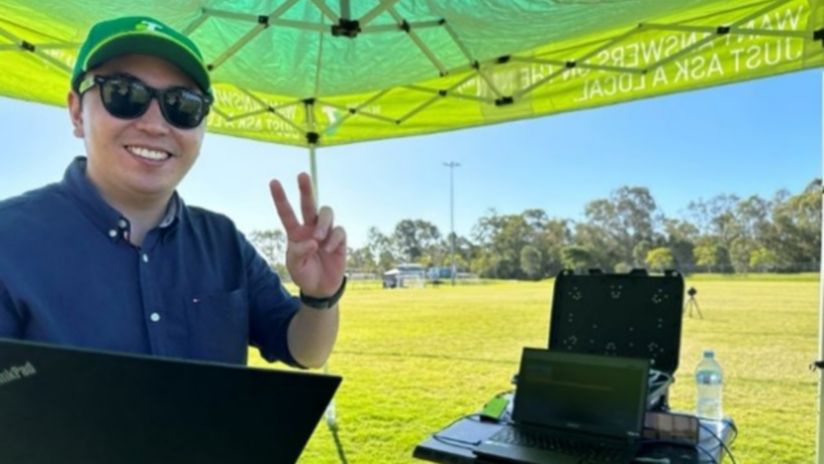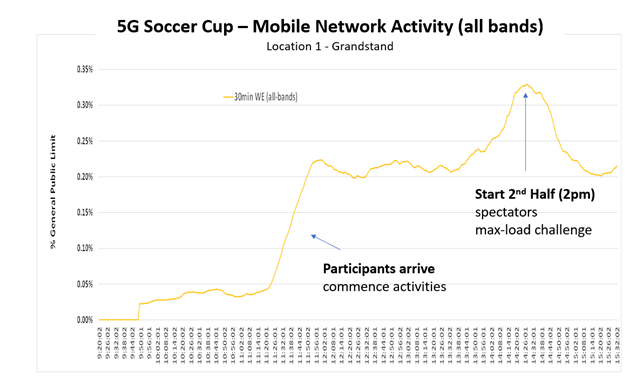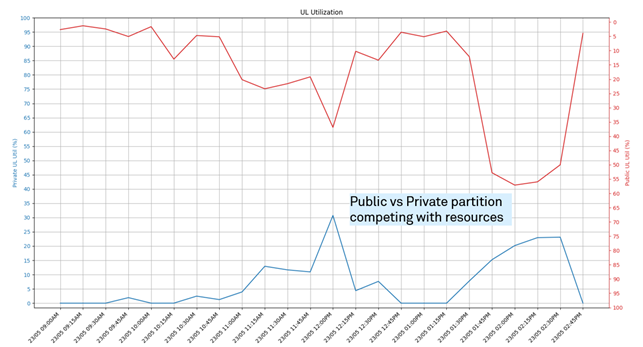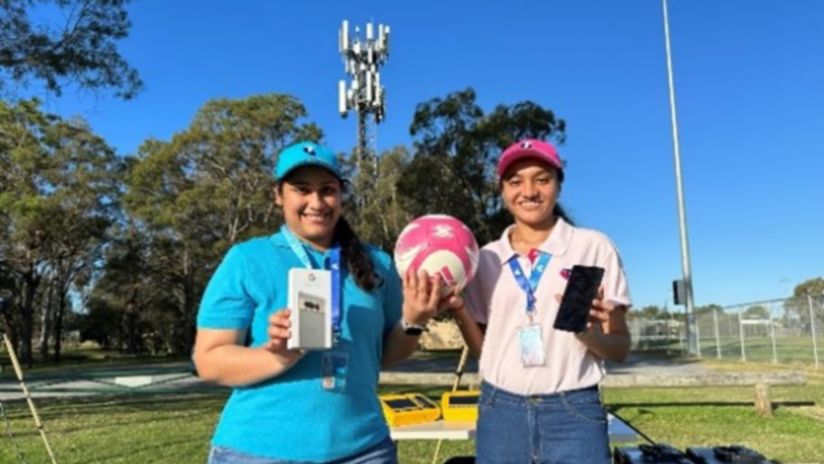Testing the power of 5G at our soccer cup
How do you inspire the next generation of technical experts? Give them inspiring projects, let them innovate with hands-on learning, throw in free data, sport, and make it fun!
0:00
What an awesome day.
0:01
It's been down at the Musgrave Mustang Soccer Club.
0:04
We've had the Telstra 5G Soccer Cup.
0:07
It's been a day of magic.
0:08
It's been a day of collaboration and innovation with our graduates and young engineers.
0:13
They've got to meet all the Telstra design experts and all the product owners that build and design our fantastic 5G network.
0:21
What that means is they get to see it first hand.
0:23
They get to come down, test the superpower of 5G and actually see how the network works.
0:29
They've been able to look inside the equipment Hut, look at all of the antennas on the tower, go and see demonstrations of the latest 5G technology, including millimeter wave which has advanced beam forming.
0:40
They got to try that first hand and see how the devices connect.
0:44
And one of the best demonstrations is we had a 5G network slice running here at the ground, which you can have a dedicated service on.
0:54
Now we our service was a HD camera, 360 camera out on the soccer pitch.
0:59
Now they had a fantastic soccer game and we were able to live stream it over 5G to all of the devices.
1:06
Now that's something that we're trialing as an application for local sport.
1:10
And you know what?
1:11
Our blue team won three goals to two.
1:14
Finally, we had our EME test team down here at Labrador at the 5G Soccer Cup and they had monitoring stations to measure the EME levels and that's part of our long term monitoring program.
1:26
So a day of innovation, a day of collaboration and learning and we were joined by the Queensland University of Technology students.
1:34
That's a wrap at the 5G Soccer Cup.
In May, Telstra’s young engineers and graduates had the incredible opportunity to immerse themselves in everything 5G around our 5G Supercell at the Telstra 5G Soccer Cup on the Gold Coast, Australia.
The grads and engineers met with Telstra’s design experts, and were able to experience the power of mmWave technology and advanced 5G beamforming. Over a dedicated standalone 5G network slice, they not only live streamed a soccer game with an ‘on field 360 HD camera’, but also conducted live EME testing of the site.

Working alongside our team at the 5G Innovation Centre to build a ‘slice’ on the new Telstra 5G standalone network, the team was able to use that slice to reserve a small portion of the network. This then provided an uninterrupted live stream of the graduate soccer game to spectators and viewers around the country.
A network slice can have many applications such as use by emergency services, government communications and in outdoor broadcasts, including the Telstra 5G Soccer Cup.
Results
The network slice ultimately provided an uninterrupted live stream to the many mobile devices at the ground, even when the network was heavily loaded. Users could watch the game in 360 degrees in whichever view they chose.
During the second half of the soccer cup, the group ran a network ‘max load challenge’ with all spectators asked to jump on their devices and use as much data as possible. Results showed a significant increase in traffic. See radio frequency network activity chart below.

The chart below shows the Cell UL Utilisation. We can see that around 2pm onwards the public and private partitions were heavily competing for resources. Despite this, we managed to provide a higher Quality of Service (QoS) with reserved dedicated radio resource for the 360-degree camera ensuring the live action was uninterrupted.

Measuring the network performance
Mobile networks are specifically designed to minimise interference especially with many users in close proximity. Therefore, it’s important to measure interference to see the effectiveness of these features.
Most of us just pick up our devices and use them without paying a thought to the network. We live stream games, chat on social media and stream the latest movies.That’s where network engineers come in – to make sure that experience is seamless. This involves detailed configurations and monitoring various network parameters as you can see in the charts below.
The data from these three charts below are great for us engineers so we can really make sure the network slice is performing well.

Left Chart - The left Cumulative Distribution Function (CDF) chart shows the Signal to Interference plus Noise Ratio (SINR) of the enterprise modem we’ve used for the network slicing demo. It could be seen that this has significantly dropped from an average of 22 dB down to 8 dB or less during the event. This was mainly due to our young and 5G-hungry graduates competing for radio resources, thus keeping the cell very busy.
Middle Chart - The Uplink (UL) throughput of the modem is displayed in the middle chart. Lower SINR usually correlates to lower throughput, however we can see that even with the SINR degradation, the Uplink throughput pretty much remained the same, meaning the live stream was uninterrupted!
Right chart - shows the Uplink (UL) power headroom, and you can see there is still some room left if more power was needed.
Putting 5G mmWave to the test
This was the next exciting challenge for our graduates and the power of mmWave. We decided to demonstrate the beamforming feature which sends a narrow beam (radio signal) to each device rather than a broad signal over a wide area. The advantage of beam forming is that you are only sending a signal to where it is needed, reducing radio interference to other mobiles which increases efficiency while also minimising EME levels.

Graduates Meghana Panthangi and Vinya Wate explain ‘we set up three spectrum analysers and three receive probes spaced apart in a straight line and used a mmWave enabled Google Pixel 7 Pro connected to our 5G network. Connecting up to the Ookla speedtest application which ensure a high-speed download rate from the base station, we walked in a straight line in front of the test probes, and the spectrum analysers detected the beam as we walked in front of the 3 probes’.
‘It was amazing, you could see the beam from the base station connected to the Pixel 7 Pro on the spectrum analysers move from the left spectrum analyser to the middle spectrum analyser, and then to the right spectrum analyser showing the beam tracking the mobile as we walked’.
Graduate Charlotte Lyons who was also instrumental in setting this up commented ‘This highly visual demonstration illustrates how a base station connects to a mmWave device with a narrow beam, something that is normally impossible to see! It’s great to be able to show all my friends and colleagues as the demo really explains the efficiency of 5G’.
EME testing – what were the radiation levels?
Our EME test team measured the EME levels and demonstrated the test procedures, reaffirming our commitment to a long-term monitoring program and we were joined by students from the Queensland University of Technology, and experts from the ACMA and ARPANSA.
For the graduates and young engineers, having the ability to set these demonstrations up, and showcase their work meant they were at the heart of the activities and learning. There is no better place to learn than hands on experimenting – this drives enthusiasm, inspiration, and innovation.
Congratulations to our victorious blue team with a thrilling three goals to two win.
It was a day of innovation, collaboration, and learning, culminating in an unforgettable 5G Soccer Cup.